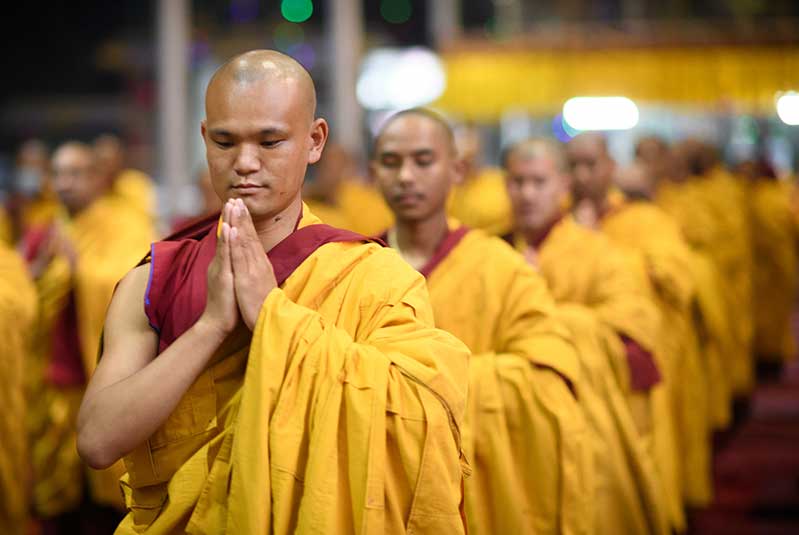Monlam Pavillion, Bodhgaya
January 28 – 30, 2020
Each year before the Kagyu Monlam begins, the monks and nuns present themselves for a short examination in monastic protocol. The review this year was held in the Monlam Pavillion in front of Khenpos from Rumtek, Sherabling, Lava, Thrangu and Benchen monasteries, and the Dorje Lopon from Zurmang. There will be an awards for the best in several categories.
The review covers all aspects of the robes which the monks and nuns wear, and the appropriate forms for making prostrations, sitting during teachings and pujas, and the tea offering.
There are fewer nunneries than monasteries at the Kagyu Monlam, and this year there were no nuns present for examination when these photographs were taken. We apologise for this.

1. A getsul [novice monk] demonstrates the first position for a prostration.

2. The second stage of prostration.

3. Monks perform the short, kneeling prostration.

4. Monks and nuns must wear a yellow prayer shawl - the chögu- during teachings and at pujas.

5. Putting on the chögu.

6. The correct way to remove the chögu.

7. Both monks and nuns place the dingwa—a red rectangular cloth—on the ground or wherever they wish to sit or lie down.

8. Tea offering: the tea bowl is cupped in the palms of both hands and raised while the monk or nun recites the offering prayers.

9. The correct way to sit during teachings and pujas.

10. Fully ordained gelongs have the most extensive examination.

11. They have to wear aadditional yellow shawl —the namjar— over the chögu.

12. Removing and folding the namjar.

13. Rolling the namjar.

14. There are rules concerning the way a gelong should carry his robes. First the dingwa is folded and placed on his left shoulder. Then the chögu is folded and placed over the dingwa. The rolled namjar is held in the crook of his left arm.

15. Removing the dingwa carefully from underneath the chögu in order to sit down.

16. The gelongs have to rehearse for the Kangyur Procession at the Mahabodhi Stupa. They carry the Buddhist scripture on their left shoulder, supporting the weight with their left hand and steadying it with their right.

17. Rehearsing how to give and receive the alms bowl.

18. The gelongs take part in the Alms Procession and have to rehearse how to carry an alms bowl. The bowl rests in the palm of their left hand, and their right hand holds the rim.



































